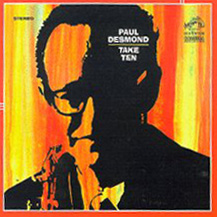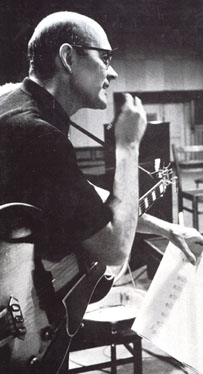

|
Soundclip:
|
| See Steve's Hand-Written Solo
Transcription |
|
Jim Hall's solo on: "Alone Together"(Dietz-Schwartz) We now bring you another wonderful Jim Hall solo which appeared on the June of 1963 Paul Desmond recording entitled, "TAKE TEN"(RCA). We are only presenting the 1st chorus of the solo because, as the chorus ended, Jim introduces some octaves and chordal punctuations, and for me, this is much too tedious to bother to write out. On this performance, and throughout virtually all of this CD, Desmond and Hall were joined by bassist, Gene Cherico, and drummer Connie Kay. The often played and recorded standard, "Alone Together" is truly one of the great structural oddities amongst the songs Jazz musicians draw from. Upon hearing it, if you catch it in the middle of someone's solo, one might think that they were listening to a minor blues with a bridge added in.  And, in truth, it can have that feeling, but it is even more curious than that, where form is concerned. It still is structured in the main A-A-B-A song form. But, the sections are not the traditional 8-bar length. [A] and [A2] are each 14 bars in length. No, not even 12-bars, but 14!!! Then, [B] is the normal 8-bar length, but is followed by [A3] which is also only 8-bars in length and the only [A] section which is like that. Strange, strange, strange! But, it of course fits the lyric and that is all that matters. In the end, it provides a great challenge for any player. And, in truth, it can have that feeling, but it is even more curious than that, where form is concerned. It still is structured in the main A-A-B-A song form. But, the sections are not the traditional 8-bar length. [A] and [A2] are each 14 bars in length. No, not even 12-bars, but 14!!! Then, [B] is the normal 8-bar length, but is followed by [A3] which is also only 8-bars in length and the only [A] section which is like that. Strange, strange, strange! But, it of course fits the lyric and that is all that matters. In the end, it provides a great challenge for any player.Probably because of Desmond's Eb alto sax, they have chosen to play the tune in C-minor. Most Jazz players play it in D-minor, though our friend, Pat Martino plays it in A-minor. So? What does one do? In which key should one learn it? Well, "THE REAL BOOK" presents it in D-minor. So, I would say, go with that key!!! Harmonically speaking, "Alone Together" does some unusual things as well. For example, the Gb°7 chord which appears in bar 9 and seems to extend the song form. It is a 'real' diminished chord, not one incorrectly labeled which would be part of some 7(b9) chordal sound. And then, at the end of [A] and [A2] the song cadences to a Cmaj7 rather than retaining its minor flavor. Our last [A], [A3], which adheres to the normal 8-bar form, does have that minor blues feeling to it, but, in the 2-bar turnaround at the end of each chorus, Jim Hall has come-up with a nice little progression to send us back to the top. Notice the descending bass line: | Gbm7 / Fm7 / | Cm7/Eb / Dm7 G7 :||. It's a very nice and clever touch by a master of harmony. Jim Hall was truly blessed with a reverence for the popular song and all its beauties and mysteries.  As usual, knowing these recordings well, Hall's solo follows Paul Desmond. As one should always consider doing, Jim Hall allows Desmond's last phrase to breath. and, rather than jumping on top of it, he waits until the middle of bar 2 to enter. This is, not only, a demonstration of respect for onešs bandmate, but also respect for the listener. It's good to be in the moment, on top of the situation, but it's also good to take a deep breath before beginning an improvisation. As it is with most of his playing during this glorious time period, Jim Hall was in the process of playing his role in modernizing guitar phrasing by continually eliminating various picked strokes. And this solo, in particular, is filled with wonderful examples of this: [A] bars 2, 13-14; [A2] bars 1 and 8; and in [B] bars 3-7. In another area, related to the guitar, let's take a look at how many "sweeps" Jim employs during the solo: [A] bars 6, 9-11, 13; [A2] bar 6; [B] last bar, as a pick-up into [A3]. You might also want to look at a most common linear device when improvising over minor areas, but it certainly is an important idea for major areas as well. It is surrounding the root[R] with the 9th and the major 7th degree below it. You can see this in: [A] bars 12-13, 14; and, in [A2] bars 3, 7-8; 12-13. As we have seen in all the prior Jim Hall solos, there are always elements of trying to develops small motifs and ideas. Such things appear in: [A] bars 9-12 13-14; [A2] bars 4-5, and 9-12. In [A3], you see that Jim mixes elements of the blues, especially when the octaves and chords appear, as well as an acknowledgment of the melody in bars 3-4. Another common device which certainly works better with only one chordal instrument, is when you have a basic repeated little minor progression like this: ||: Cm7 / / / | Dm7b5 / G7 / :|| is to employ a D7(alt.) chord as a substitute for the Dm7b5, and an Ab7 chord works nicely an alternative to that. To create variety and interest, you often here such notes played by bassists. Perhaps the best linear example of this is in [A3] at bar 6 as part of a beautifully arpeggiated sequence. I mentioned earlier that "Alone Together" can have the appearance being some kind of a minor blues once the soloing has commenced. I wanted to follow-up on this thought and mention some other tunes which can give this same impression if one doesn't recognize other crucial elements. Those other songs could include: "Softly as in a Morning Sunrise"; "Beautiful Love"; "Dear Old Stockholm"; "You'd Be So Nice to Come Home To"; and "Lullaby of the Leaves." There are countless others as well. With summer set to arrive, it is our hope that you will have enjoyed yet another wonderful Jim Hall solo, and that seeing it, hearing it, and reflecting upon it, with the help of this analysis, will supply each of you with valuable information and inspiration to put what has been shared to good use in your own music. Have a great summer, and we will see you next month at one "Korner" or the other!!!
[Photo of Jim Hall by: Jutta Matthess from "IT'S NICE TO BE WITH YOU"(MPS) Germany, '69]
|